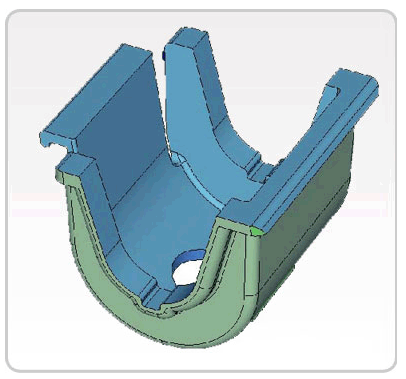By Protomold – Nobody’s Faster In The Short Run.®
When the designers of the Great Seal of the United States included the phrase “E pluribus unum” (Latin for “out of many, one”), they certainly weren’t thinking about plastic parts. They did, however, recognize the many benefits of unifying separate entities into a single, strong unit, and that certainly holds true for parts.
Joining mechanical assemblies into a single injection molded piece can reduce the cost of production in a number of ways. Producing a single molded part is typically a one-step process; producing an assembly is, almost by definition, more complicated. If the parts being replaced were produced by a non-molding process—machining for example—the molding process will almost certainly be less costly. Because plastic resin is a relatively inexpensive material, there’s a good chance that the original materials themselves, if they were not plastic resin, cost more. And then there’s the expense of ordering, stocking and assembling multiple parts, which is often the largest cost component and is eliminated if you mold the assembly as one.
Also, there’s the future cost of maintenance and, if necessary, replacement. A well-designed plastic part will tend to stay in one piece for life. An assembly, on the other hand, can loosen at the joints or literally “come apart at the seams” requiring preventive maintenance, repair, or replacement. In addition, there can be collateral damage when connections loosen, systems go out of alignment, or equipment breaks while in service. An excellent example of part count reduction is the redesign of a bearing hanger assembly used to support the grit-roll shaft in a large-format printer. Six hanger assemblies were used in each machine, and each assembly consisted of seven parts including the screws holding the parts together, for a total of 42 separate parts in each printer. Engineers set out to reduce that total number to six.

Figure 1 – Example of single molded part designed to replace multiple part assemblies.
Obviously, the redesign involved more than ordering the same parts in plastic resin. In fact, the new single part doesn’t look at all like the assembly it replaces. It is significantly wider and provides two cradles for the shaft instead of one (see Figure 1). It does not require a bearing insert because the resin itself—RTP 200 AR15 TFE155, a blend that includes nylon and TFE, also marketed as Teflon®—has excellent wear and low-friction properties. The injected resin also contains aramid fiber (Kevlar®) for added strength and wear resistance. This combination proved to be an excellent choice since wear tests of the part exceeded goals; the plastic bearing wore less in tests than the stainless steel shaft it supports.
Finally, the cost of fasteners was eliminated and installation simplified by designing the new bearings to snap into place in the printer’s platen. Finite element analysis (FEA) of the new design predicted that the bearing clip would flex during installation without breaking. Even including the cost of tooling for the new mold, over the life of the printer, the cost of the all-in-one part was far smaller than that of the assembly it replaced.
The views, opinions and technical analyses presented here are those of the author or advertiser, and are not necessarily those of ULProspector.com or UL Solutions. The appearance of this content in the UL Prospector Knowledge Center does not constitute an endorsement by UL Solutions or its affiliates.
All content is subject to copyright and may not be reproduced without prior authorization from UL Solutions or the content author.
The content has been made available for informational and educational purposes only. While the editors of this site may verify the accuracy of its content from time to time, we assume no responsibility for errors made by the author, editorial staff or any other contributor.
UL Solutions does not make any representations or warranties with respect to the accuracy, applicability, fitness or completeness of the content. UL Solutions does not warrant the performance, effectiveness or applicability of sites listed or linked to in any content.


